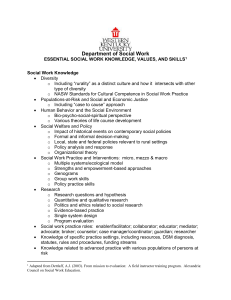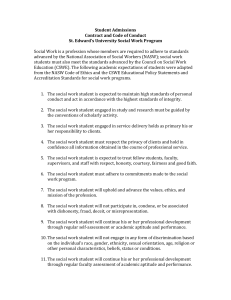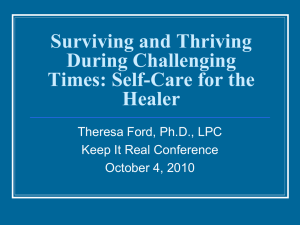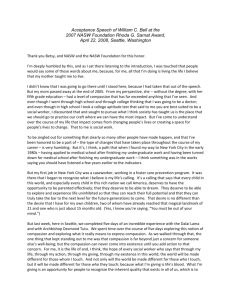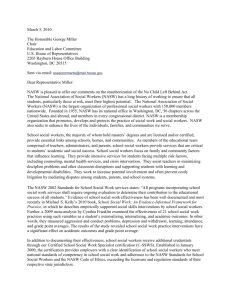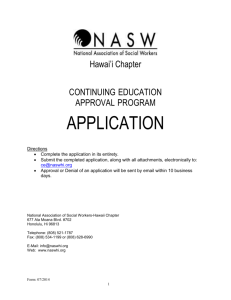S8 - National Association of Social Workers NC Chapter
advertisement
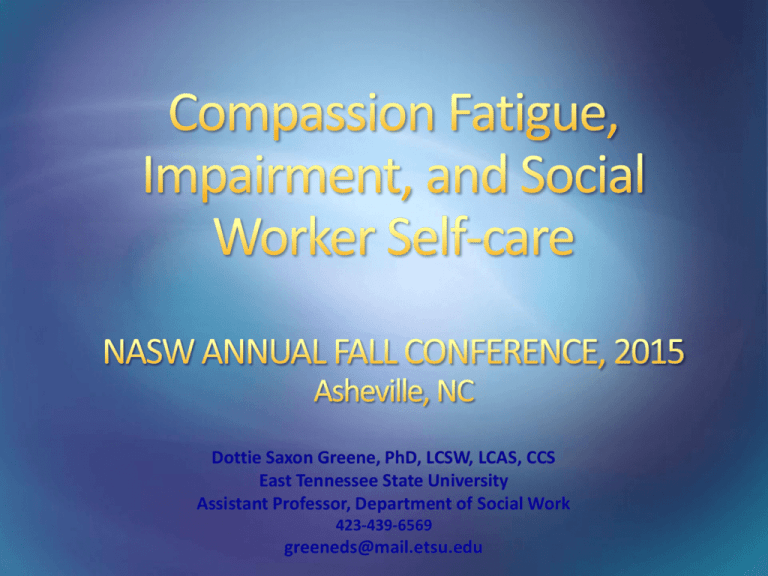
Dottie Saxon Greene, PhD, LCSW, LCAS, CCS East Tennessee State University Assistant Professor, Department of Social Work 423-439-6569 greeneds@mail.etsu.edu OVERVIEW RATIONALE FOR THE TOPIC COMPASSION FATIGUE, STS, VT, BO, AND IMPAIRMENT WHAT DOES THE RESEARCH SAY? PROFESSIONAL AND ETHICAL RESPONSIBILITES SELF-CARE SELF-ASSESSMENTS SELF-CARE, SELF-CARE, SELF-CARE, Blah, Blah, Blah….. WHAT’S ALL THE HOOPLAH ABOUT? YOU ARE THE TOOL! OUR CLIENTS DESERVE THE BEST WE CAN BRING FORTH! YOU DESERVE THE BEST YOU! YOU CANNOT TAKE A CLIENT BEYOND THAT WHICH YOU ARE! SOCIAL WORKERS DON’T STOP BEING HUMAN OCCUPATIONAL HAZARDS NASW CODE OF ETHICS CSWE COMPETENICES AND PRACTICE BEHAVIORS TERMS/CONSTRUCTS COMPASSION FATIGUE BURNOUT SECONDARY TRAUMATIZATION VICARIOUS TRAUMA IMPAIRMENT Seminal works’ authors Christine Maslach Charles Figley Beth Stamm Pearlman & Saakvitne PROFESSIONAL QUALITY OF LIFE: Compassion Satisfaction & Compassion Fatigue Courtesy of Beth Stamm, PhD www.proqol.org 5 Professional Quality of Life (PROQL) the quality one feels in relation to their work as a helper • Compassion Satisfaction – Positive aspects of working as a helper • Compassion Fatigue – Negative aspects of working as a helper Burnout – Inefficacy and feeling overwhelmed, unhappiness, exhaustion, disconnectedness, insensitivity to work environment Work-related traumatic stress – Primary traumatic stress direct target of event – Secondary traumatic exposure to event due to a relationship with the primary person 6 Compassion Satisfaction • The positive aspects of helping – Pleasure and satisfaction derived from working in helping, care giving systems – Work is invigorating • May be related to – – – – – Providing care The system Work with colleagues Beliefs about self Altruism 7 SECONDARY TRAUMATIC STRESS Preoccupied with thoughts of people helped Feeling trapped, on edge, exhausted, overwhelmed, and “infected” by others’ trauma Inability to sleep Forgetfulness Inability to separate private life from helper life Experiencing the trauma of someone helped Can be identical to PTSD Avoidance, arousal & numbing Re-experiencing, intrusive recollection Distress & impairment 8 VT: A process of cognitive [change] resulting from [chronic] empathic engagement with trauma survivors” (Pearlman, 1992, p. 52). Shift in worldview related to beliefs to core beliefs about Sense of self Safety Trust Intimacy Control Spirituality (Pearlmann, 1998; Pearlmann & McIan, 1995; Pearlman & Saakvitne, 1995) According to Figley (1995), STS more related to behavioral sxs rather than intrinsic cognitive changes STS mimics PTSD VT cognitive change process “A state of physical, emotional, psychological, and spiritual exhaustion resulting from chronic exposure to (or practice with) populations that are vulnerable or suffering (Pines & Aronson, 1998). A process that occurs over time (indv & organization) Meta-construct Exhaustion Depersonalization Reduction in one’s sense of personal accomplishment Professional Quality of Life Compassion Satisfaction The positive aspects of helping “The good stuff” Compassion Fatigue The negative aspects of helping “The bad stuff’ 12 Relationships Are Complex • Multiple spheres – Work environment – “People helped” environment – Personal environment • Positive (CS) & negative (CF) • Altruism CS can override CF • Compassion Fatigue two parts – Worn out (BO) common – Frightened, traumatized (STS) rarer but powerful 13 Complex Relationships Work Environment Professional Quality of Life Compassion Satisfaction (ProQOL CS) Exhaustion Client Environment Compassion Fatigue Depressed by Work Environment (ProQOL Burnout) Frustration Anger Secondary Exposure (ProQOL STS) Personal Environment Traumatized by work 14 Primary Exposure Impairment Defined According to Barker (2003), an impaired social worker is one who is unable to function adequately as a professional social worker and provide competent care to clients as a result of a physical or mental disorder or personal problems, or the ability or desire to adhere to the code of ethics of the profession. The problems most commonly include alcoholism, substance abuse, mental illness, burnout, stress, and relationship problem.” (p. 210) 15 Manifestations of Impairment AOD use issues Depression (3 xs the rate of general pop (Seibert, 2004)) Vicarious trauma Secondary traumatization (PTSD-like sxs) Burnout (70% lifetime rate (Seibert, 2005)) Compassion fatigue Unethical conduct Professional mistakes Failure to provide competent care 16 Manifestations of Impairment, cont. Absenteeism Cancelled appointments Late for work Pessimistic Hoping for cancellations Impatience 17 Consequences of Impairment Compromises performance Jeopardizes client safety Damages reputation of agency/organization Damaging to the reputation of social work profession Raises questions about the competency of the profession as a whole Harms experienced by the distressed social worker 18 Social workers who identified the following personal history issues were more likely to experience professional impairment. Alcohol and drug misuse by a parent, partner, family member, or close friend; Having a troubled parent Physical, sexual, or emotional abuse. Parentification as a child Fledgling social workers are at higher risk for compassion fatigue (CF) and burnout (BO) compared to those who have longevity in the field and are older in age. (Newell & MacneNeil, 2010; Salloum, Kondrat, Johnson & Olson, 2014) Social workers are more likely to consider leaving the field during their first four years in practice (Whitaker, Weismiller, & Clark, 2006). Bride, Jones, and Macmaster (2007) found with child welfare workers that 92% of respondents reported at least one symptom of STS at least occasionally. Salloum and associates (2014) reported 30% 60 % burnout rate Seibert (2005) found 39% practicing SWers currently experiencing BO with a nearly 75% lifetime rate of BO A study conducted for NASW found additional work-related stressors which contribute to burnout: having more responsibilities than they can handle; needing to complete routine task that have little intrinsic value; having few opportunities for advancement/promotion; being expected work long hours; receiving few resources to adequately accomplish work tasks; having conflicting or unclear job expectations; getting minimal support form co-workers and supervisors; and, being unable to balance professional and personal life. (Arrington, 2008, p. 3) PROFESSIONAL & ETHICAL RESPONSIBILITIES: NASW CODE OF ETHICS & COUNCIL ON SOCIAL WORK EDUCATION Ethical principles of psychologists 2.06 Personal problems and conflicts Code of ethics of the NASW 2.09 Impairment of colleagues 2.10 Incompetence of colleagues ACA code of ethics C.2g Impairment C2.h Counselor incapacitation… F5b Student & supervisor responsibilities Impairment AAMFT code of ethics Principles of medical ethics (psychiatrists) AMHCA code of ethics (Zur Institute, n.d.) NASW’s standard 2.09 mandates that: (a) Social workers who have (b) Social workers who believe direct knowledge of a that a social work social work colleague’s colleague’s impairment impairment that is due to interferes with practice personal problems, effectiveness and that the psychosocial distress, colleague has not taken substance abuse , or adequate steps to address mental health difficulties, the impairment should take and that interferes with action through appropriate practice effectiveness channels established by should consult with that employers, agencies, NASW, colleague when feasible licensing and regulatory and assist the colleague in bodies, and other taking remedial action. professional organizations. 26 NASW’s standard 4.05 mandates that: (a) Social workers should not allow (b) Social workers whose personal their own personal problems, problems, psychosocial distress, psychosocial distress, legal legal problems, substance abuse, problems, substance abuse, or or mental health difficulties mental health difficulties to interfere with their professional interfere with their professional judgment and performance judgment and performance or to should immediately seek jeopardize the best interests of consultation and take people for whom they have a appropriate remedial action by professional responsibility. seeking professional help, making adjustments in workload, terminating practice, or taking any other steps necessary to protect clients and others. 27 NASW POLICY STATEMENT RE: IMPAIRMENT Since the ability to perceive situations clearly and objectively is pivotal in social work, impairment may compromise performance and, thus, jeopardize the rights of clients and treatment effectiveness (NASW, 2008). NASW POLICY STATEMENT RE: IMPAIRMENT NASW recognizes that the prevention, identification, and treatment of professional impairment is vital to protect the welfare of clients, practicing social workers, the work environment, and the integrity of the profession. A multi-systemic approach, focusing on prevention, identification, and treatment, must be used to address professional impairment among social workers (NASW, 2008). COUNCIL ON SOCIAL WORK EDUCATION: Educational Policy and Accreditation Standards • Educational Policy 2.1.1—Identify as a professional social worker and conduct oneself accordingly. • Social workers serve as representatives of the profession, its mission, and its core values. They know the profession’s history. Social workers commit themselves to the profession’s enhancement and to their own professional conduct and growth. Social workers • advocate for client access to the services of social work; • practice personal reflection and self-correction to assure continual professional development; • attend to professional roles and boundaries; • demonstrate professional demeanor in behavior, appearance, and communication; • engage in career-long learning; and • use supervision and consultation. NASW recognizes and acknowledges the unique and valuable contributions of the professional social worker. NASW supports the practice of professional self-care for social workers as a means of maintaining their competence, strengthening the profession, and preserving the integrity of their work with clients. Education, self-awareness, and commitment are considered key to promoting the practice of professional self-care. (NASW, 2008, p.270) “Process of purposeful engagement in practices that promote holistic health and well-being of the self” (Lee and Miller, 2013,p. 98). “Professional self-care can be defined as the utilization of skills and strategies by social workers to maintain their own personal, familial, emotional, and spiritual needs while attending to the needs and demands of their clients” (Figley, Stamm, and NASW as cited by Newell &Nelson-Gardell (2014) p. 431). Large caseloads Caseloads with high acuity, chronicity, and trauma Lack of client resources Inadequate supervision Restraints and limitations of bureaucratic systems Inadequate compensation Lack of professional support and professional development opportunities Safety concerns Lack of recognition and autonomy Organizational culture (Cox & Steiner, 2013; Lee & Miller, 2013; Napoli & Bonifas, 2011; NASW, 2008; Newell & MacNeil, 2010; Newell & Nelson-Gardell, 2014; Salloum et al., 2015; Seibert, 2005). PREVENTION & INTERVENTION: SELF-CARE Mental health hygiene Eat well Sleep well Exercise regularly Humor Spirituality Mindfulness Hobbies Social support Personal therapy Vacation Work-related self-care Do NOT work overtime Learn to say “No” Regular supervision Peer supervision Advocate for manageable caseloads Professional development activities Do NOT bring work home Organizational culture of wellness 35 The Burnout Measure, Short Version (Maslach-Pines, 2005) Use the following scale 1 2 never almost never 3 rarely 4 sometimes 5 often 6 very often 7 always 1. Tired ______ 2. Disappointed with people_______ 3. Hopeless______ 4. Trapped______ 5. Helpless_______ 6. Depressed_____ 7. Physically weak/Sickly_____ 8. Worthless/Feel like a failure____ 9. Difficulties sleeping_______ 10. “I’ve had it” _______ Up to 2.4 indicates low burnout; between 2.5-3.4 indicates danger signs; 3.5 4.4 indicates burnout; 4.5-5.4 serious problem of burnout; Score of 5.5 requires immediate professional intervention. 36 References Arrington, P. (2008) Stress at work: How do social workers cope?. NASW Membership Workforce Study. Washington, DC: National Association of Social Workers Barker, R. L. (2003). The social work dictionary. Baltimore, MD: NASW Press Council on Social Work Education. Commission on Accreditation (2008). 2008 EPAS Handbook. Retrieved from http://www.cswe.org/Accreditation/2008EPAS Handbook.aspx Cox, K. and Steiner, S. (2013). Self-care in social work: A guide for practitioners, supervisors, and administrators. Washington, DC: NASW Press. Lee, J. J. & Miller, S. E. (2013). A self-care framework for social workers: Building a strong foundation for practice. Families in Society: The Journal of Contemporary Social Services, (94) 2, 96-103. doi:10.1606/10443894.4289. Napoli, M. & Bonifas, R. (2011). From theory toward empathic self-care: Creating a mindful classroom for social work students. Social Work Education, 30(5), 635-649. doi:10.1080/01615479.2011586560 Maslach-Pines, A. (2005). The burnout measure, short version. International Journal of Stress management, 12(1), 78-88. National Association for Social Workers (2006). Professional impairment. Social Work Speaks (7th ed.). Washington, DC: NASW Press. Newell, J. M. & Nelson-Gardell, D. (2014). A competency based approach to teaching professional self-care: An ethical consideration for social work educators. Journal of Social Work Education, 50, 427-439. doi:10,1080/1043 7797.2014917928. Newell, J. M. & MacNeil, G. A. (2010). Profession burnout, vicarious trauma, secondary traumatic stress, and compassion fatigue: Review of theoretical terms, risk factors, and preventive methods for clinicians and researchers. Best Practice in Mental Health, 6(2), 58-68 Pearlman, L. A., & Saakvitne, K. W. (1995). Trauma and the therapist: countertransference and vicarious traumatization in psychotherapy with incest survivors. New York: Norton Pearlman, L. A. & McIan, P. S. (1995). Vicarious traumatization: An empirical study of the effects of trauma work on trauma therapists. Jounral of Psychology: Research and Practice, 26(6), 558-565.(1998) Pooler, D. C., Siebert, D. C., Faul, A. C., & Huber, R. (2008). Personal history and professional impairment: Implications for social workers and their employers. Administration in Social Work, 32(2), 69-85. doi.org/10.1300/j147v32n02_05 Seibert, D. C. (2003). Denial of AOD use: An issue for social workers and the profession. Health and Social Work, 28(2), 8997. doi.org/10.1093/hsw/ 8.2.89 Siebert, D.C. (2004). Depression in North Carolina social workers. Social Work Research, 28(1), 29-40. doi.org/10.1093/swr/28.1.30 Siebert, D.C. (2005). Personal and occupational factors in burnout among practicing social workers: Implications for researchers, practitioners, and managers. Journal of Social Services Research, 32(2), 25-45. doi.org/10.1300/j079v32n02_02 Siebert, D.C. (2005). Help seeking for AOD misuse among social workers: Patterns, barriers and implication. Social Work, 50(1), 65-74.doi.org/10.1093/sw/50.1.65 Stamm, B. H. (2015). PROQL.org. Retrieved from http://proqol.org/Home_Page.php Whitaker, T., Weismiller, T., & Clark, E. (2006). Assuring the sufficiency of a frontline workforce: A national study of licensed social workers. (Executive summary). Washington, DC: National Association of Social Workers. Retrieved from http://workforce.socialworkers.org/studies/nasw_06_execsummary.pdf. Zur. O. (n.d.). Codes of ethics on therapists' impairment, burnout and self-care. Retrieved from Zur Institute website: http://www.zurinstitute.com/ethicsofburnout.html
